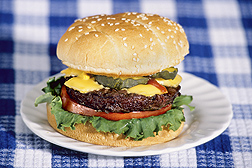This page has been archived and is being provided for reference purposes only. The page is no longer being updated, and therefore, links on the page may be invalid.
| Read the magazine story to find out more. |
|
|
|
|
Food Safety Study of Beef "Trim" Leads to Ongoing Research Collaboration
By Marcia WoodApril 5, 2011
Burgers, meat loaf and other lean ground beef favorites may be made from "trim," the meat that's left over after steaks and roasts have been carved from a side of beef. A study conducted several years ago to ensure that imported beef trim is safe to eat has led to an ongoing collaboration between U.S. Department of Agriculture (USDA) scientists who conducted the research and colleagues from Uruguay, which exports this in-demand beef.
Microbiologist Joseph M. (Mick) Bosilevac with USDA's Agricultural Research Service (ARS) and his colleagues examined 1,186 samples of beef trim from the United States and from Australia, New Zealand and Uruguay, three nations that provide more than half of America's beef imports. The research had been requested because questions had been raised as to whether America's procedures for monitoring the safety of imported beef trim were adequate for detecting pathogens such as Escherichia coli in trim.
One concern was that foodborne pathogens and their reported incidence aren't necessarily the same from one part of the world to the next. For example, while E. coli O157:H7 is the leading species, or serotype, in severe E. coli-associated foodborne illness in the northern hemisphere, in the southern hemisphere other toxin-producing E. coli serotypes such as O111 have also been associated with outbreaks of foodborne illness, according to Bosilevac. He works at the ARS Roman L. Hruska U.S. Meat Animal Research Center at Clay Center, Neb.
The researchers looked for contaminants such as Staphylococcus aureus, Campylobacter, Salmonella, Listeria, and near relatives of E. coli O157:H7 that can cause severe foodborne illness.
Results indicated that the pathogen-monitoring procedures used in the United States today are adequate for evaluating the safety of imported beef trim.
Bosilevac and Michael N. Guerini, Dayna M. Brichta-Harhay and Terrance M. Arthur at the ARS center, as well as former ARS colleague Mohammad Koohmaraie, reported the work in the Journal of Food Protection in 2007. In the years since then, Bosilevac and Clay Center research leader Tommy L. Wheeler have presented information about the research center's pathogen detection technologies to colleagues at several of Uruguay's national laboratories and at the Instituto Nacional de Investigación Agropecuaria, the Uruguayan counterpart of USDA.
ARS is the USDA's chief intramural scientific research agency. ARS and the Beef Checkoff Program sponsored the research, which supports the USDA priority of enhancing food safety.
Read more about this research in the April 2011 issue of Agricultural Research magazine.

